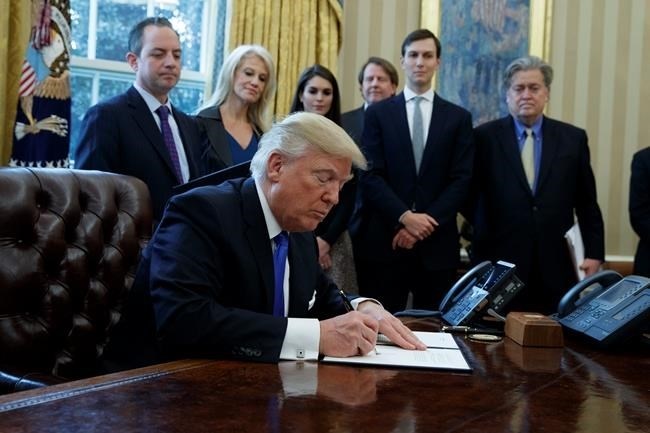
President Donald Trump signs an executive order on the Keystone XL pipeline, Tuesday, Jan. 24, 2017, in the Oval Office of the White House in Washington.
Image Credit: AP Photo/Evan Vucci
January 24, 2017 - 7:45 PM
WASHINGTON - A zombie project that has spent years haunting Canada-U.S. relations in its never-born-yet-never-quite-dead state of perpetual limbo has just been given hope of life by new U.S. President Donald Trump.
The Keystone XL pipeline is alive — maybe.
Trump revived hopes for the dormant project Tuesday. He signed an executive order that could build the Alberta-to-Texas pipeline, the subject of a multi-year saga that cast a long shadow on bilateral relations.
He signed several executive orders related to infrastructure and construction, with the highest-profile one involving the pipeline that, if completed, would carry more than one-fifth of the oil Canada exports to the U.S..
The order invites pipeline-maker TransCanada Corp. to re-submit an application for a permit. It also encourages U.S. federal regulatory agencies to respond the opposite way the Obama administration did: favourably, and quickly, within 60 days.
"(It) directs agencies to approve it without delay," Trump spokesman Sean Spicer said Tuesday.
"There's an energy revolution that's gonna happen in this country. In spite of the bureaucratic and political barriers that have happened in the past, we're ready to move forward."
The company issued a statement several hours later confirming it would re-apply: "We are currently preparing the application and intend to do so."
But it remains far from a done deal. There's ongoing uncertainty on multiple fronts — some are anticipated legal and political fights, and others are less-predictable wrinkles introduced Tuesday by the president himself.
The White House said its executive orders insist on two things: a better Keystone deal for U.S. taxpayers, and pipes made from U.S. steel, which could be problematic given that the parts for Keystone were already purchased, are now sitting in outdoor yards, and they include mostly foreign steel.
"We're going to renegotiate some of the terms," Trump said, as he signed the presidential order. "And if they'd like, we'll see if we can get that pipeline built."
The actual wording of those orders isn't actually that tough. It instructs the U.S. secretary of state to make a decision within 60 days, including on any new conditions that might serve the U.S. national interest.
As for the requirement to use U.S. steel, a separate presidential order sets a relatively low bar. It asks the commerce secretary to come up with a plan to use American material to the maximum extent possible, and to the maximum extent allowed by law.
Other promised challenges to the pipeline are entirely predictable.
Jane Kleeb, a political activist who initially organized Nebraska farmers against the project, listed a half-dozen remaining obstacles, including: a constitutional battle over the state's pipeline law, a new permitting process in Nebraska, and potential protests and legal actions by indigenous peoples in South Dakota.
"It's absolutely disgusting that Donald Trump is now going to use eminent domain for private gain against American farmers for a foreign pipeline," Kleeb said.
"(He) wants to build a wall to protect America from Mexico — and yet here he is saying that any foreign country can now pierce our border with a pipeline without any federal review."
Within hours came word of a protest planned for later Tuesday outside the White House, a clear foreshadowing of the political fight that looms.
Keystone XL would carry more than one-fifth of the oil Canada exports to the United States, taking it to the already-built southern leg that connects with major refineries on the Gulf of Mexico.
Americans have a stake in the project too. The pipeline would include some oil picked up in the northern U.S., and it would also share resource royalties with a string of communities along the route, increasing some counties' annual revenues more than half.
Canada's oil exports have continued flowing, even without that pipeline.
The amount of Canadian oil sent to the U.S. has increased more than 60 per cent since TransCanada Corp. first applied for a permit in 2008. Those exports have largely rolled into the U.S. on trains.
An organizer of the first national protests, Bill McKibben, explained in a 2015 interview why he fought to stop the pipeline: To complicate development of the oilsands, in the hope of speeding up the global shift to clean energy.
"We can't bankrupt the fossil-fuel industry," McKibben said at the time. "But we can begin to politically bankrupt them — and we're trying."
News from © The Canadian Press, 2017